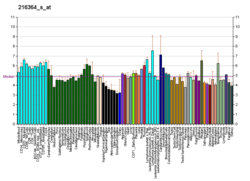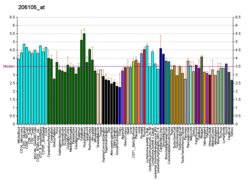AFF2
AF4/FMR2 family member 2 is a protein that in humans is encoded by the AFF2 gene.[3] Mutations in AFF2 are implicated in cases of breast cancer.[4]
CCG repeat expansions in this gene are associated with X-linked intellectual disability and specifically a syndrome known as Fragile XE mental retardation (FRAXE). FRAXE is one of the most common forms of non-syndromic X-linked mental retardation. The gene is also known as FMR2 (Fragile Mental Retardation 2) after this condition.[5]
Genomics
This gene is located on the long arm of chromosome X (Xq27.3-Xq28) It has 22 exons spanning at least 500 kb. Alternative splicing may occur and involve exons 2, 3, 5, 7 and 21. The normal encoded protein is 1311 codons in length. It is expressed as an 8.7 kilobase transcript in the placenta and adult brain.
The normal 5' untranslated region has 10-35 CCG repeats and more frequently 15-20. Pathogenic expansions have typically over 200 repeats and are methylated.
This gene belongs to the AFF family of genes which currently has four members: AFF1/AF4, AFF2/FMR2, AFF3/LAF4 and AFF4/AF5q31.[6] All AFF proteins are localized in the nucleus and have a role as transcriptional activators with a positive action on RNA elongation. AFF2/FMR2, AFF3/LAF4 and AFF4/AF5q31 localize in nuclear speckles (subnuclear structures considered to be storage/modification sites of pre-mRNA splicing factors) and are able to bind RNA with a high apparent affinity for the G-quadruplex structure. They appear to modulate alternative splicing via the interaction with the G-quadruplex RNA-forming structure.
The other members of this family have been reported to form fusion genes as a consequence of chromosome translocations and are involved in the pathogenesis of myeloid/lymphoid or mixed lineage leukemia.
References
- GRCh38: Ensembl release 89: ENSG00000155966 - Ensembl, May 2017
- "Human PubMed Reference:". National Center for Biotechnology Information, U.S. National Library of Medicine.
- "Entrez Gene: AFF2 AF4/FMR2 family, member 2".
- The Cancer Genome Atlas Network (October 2012). "Comprehensive molecular portraits of human breast tumours". Nature. 490 (7418): 61–70. Bibcode:2012Natur.490...61T. doi:10.1038/nature11412. PMC 3465532. PMID 23000897.
- Stettner GM, Shoukier M, Höger C, Brockmann K, Auber B (August 2011). "Familial intellectual disability and autistic behavior caused by a small FMR2 gene deletion". American Journal of Medical Genetics. Part A. 155A (8): 2003–7. doi:10.1002/ajmg.a.34122. PMID 21739600.
- Melko M, Douguet D, Bensaid M, Zongaro S, Verheggen C, Gecz J, Bardoni B (May 2011). "Functional characterization of the AFF (AF4/FMR2) family of RNA-binding proteins: insights into the molecular pathology of FRAXE intellectual disability". Human Molecular Genetics. 20 (10): 1873–85. doi:10.1093/hmg/ddr069. PMID 21330300.
Further reading
- Mulley JC, Yu S, Loesch DZ, Hay DA, Donnelly A, Gedeon AK, Carbonell P, López I, Glover G, Gabarrón I (March 1995). "FRAXE and mental retardation". Journal of Medical Genetics. 32 (3): 162–9. doi:10.1136/jmg.32.3.162. PMC 1050310. PMID 7783162.
- Gecz J, Gedeon AK, Sutherland GR, Mulley JC (May 1996). "Identification of the gene FMR2, associated with FRAXE mental retardation". Nature Genetics. 13 (1): 105–8. doi:10.1038/ng0596-105. PMID 8673085.
- Gu Y, Shen Y, Gibbs RA, Nelson DL (May 1996). "Identification of FMR2, a novel gene associated with the FRAXE CCG repeat and CpG island". Nature Genetics. 13 (1): 109–13. doi:10.1038/ng0596-109. PMID 8673086.
- Chakrabarti L, Knight SJ, Flannery AV, Davies KE (February 1996). "A candidate gene for mild mental handicap at the FRAXE fragile site". Human Molecular Genetics. 5 (2): 275–82. doi:10.1093/hmg/5.2.275. PMID 8824884.
- Gécz J, Oostra BA, Hockey A, Carbonell P, Turner G, Haan EA, Sutherland GR, Mulley JC (March 1997). "FMR2 expression in families with FRAXE mental retardation". Human Molecular Genetics. 6 (3): 435–41. doi:10.1093/hmg/6.3.435. PMID 9147647.
- Gecz J, Bielby S, Sutherland GR, Mulley JC (September 1997). "Gene structure and subcellular localization of FMR2, a member of a new family of putative transcription activators". Genomics. 44 (2): 201–13. doi:10.1006/geno.1997.4867. PMID 9299237.
- Chakrabarti L, Bristulf J, Foss GS, Davies KE (March 1998). "Expression of the murine homologue of FMR2 in mouse brain and during development". Human Molecular Genetics. 7 (3): 441–8. doi:10.1093/hmg/7.3.441. PMID 9467002.
- Gecz J, Mulley JC (1999). "Characterisation and expression of a large, 13.7 kb FMR2 isoform". European Journal of Human Genetics. 7 (2): 157–62. doi:10.1038/sj.ejhg.5200279. PMID 10196698.
- Murray A, Webb J, Dennis N, Conway G, Morton N (October 1999). "Microdeletions in FMR2 may be a significant cause of premature ovarian failure". Journal of Medical Genetics. 36 (10): 767–70. doi:10.1136/jmg.36.10.767. PMC 1734234. PMID 10528856.
- Dias Neto E, Correa RG, Verjovski-Almeida S, Briones MR, Nagai MA, da Silva W, Zago MA, Bordin S, Costa FF, Goldman GH, Carvalho AF, Matsukuma A, Baia GS, Simpson DH, Brunstein A, de Oliveira PS, Bucher P, Jongeneel CV, O'Hare MJ, Soares F, Brentani RR, Reis LF, de Souza SJ, Simpson AJ (March 2000). "Shotgun sequencing of the human transcriptome with ORF expressed sequence tags". Proceedings of the National Academy of Sciences of the United States of America. 97 (7): 3491–6. Bibcode:2000PNAS...97.3491D. doi:10.1073/pnas.97.7.3491. PMC 16267. PMID 10737800.
- Lo Nigro C, Faravelli F, Cavani S, Perroni L, Novello P, Vitali M, Bricarelli FD, Grasso M (March 2000). "FRAXE mutation in a mentally retarded subject and in his phenotypically normal twin brother". European Journal of Human Genetics. 8 (3): 157–62. doi:10.1038/sj.ejhg.5200425. PMID 10780779.
- Tzeng CC, Tzeng PY, Sun HS, Chen RM, Lin SJ (June 2000). "Implication of screening for FMR1 and FMR2 gene mutation in individuals with nonspecific mental retardation in Taiwan". Diagnostic Molecular Pathology. 9 (2): 75–80. doi:10.1097/00019606-200006000-00002. PMID 10850542.
- Musumeci SA, Scuderi C, Ferri R, Anello G, Salluzzo R, Bosco P, Elia M (September 2000). "Does a peculiar EEG pattern exist also for FRAXE mental retardation?". Clinical Neurophysiology. 111 (9): 1632–6. doi:10.1016/S1388-2457(00)00367-9. PMID 10964075.
- Hillman MA, Gecz J (2001). "Fragile XE-associated familial mental retardation protein 2 (FMR2) acts as a potent transcription activator". Journal of Human Genetics. 46 (5): 251–9. doi:10.1007/s100380170074. PMID 11355014.
- Kitano T, Schwarz C, Nickel B, Pääbo S (August 2003). "Gene diversity patterns at 10 X-chromosomal loci in humans and chimpanzees". Molecular Biology and Evolution. 20 (8): 1281–9. doi:10.1093/molbev/msg134. PMID 12777533.
- Brylawski BP, Chastain PD, Cohen SM, Cordeiro-Stone M, Kaufman DG (April 2007). "Mapping of an origin of DNA replication in the promoter of fragile X gene FMR1". Experimental and Molecular Pathology. 82 (2): 190–6. doi:10.1016/j.yexmp.2006.10.004. PMC 1934615. PMID 17196195.




